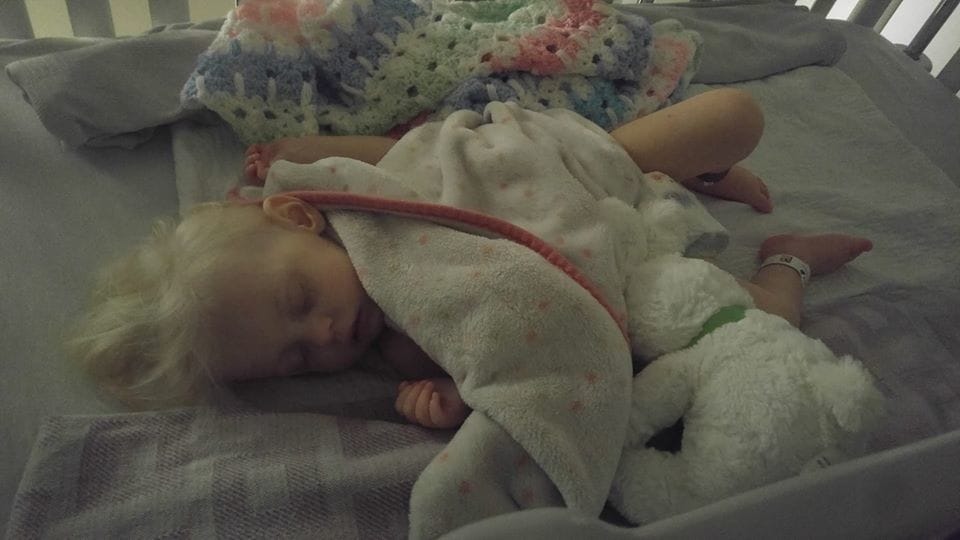What parents need to know about that viral milk anemia story

It might be scary, but we break it down, mama.
Table of Contents
When Anastacia Gencarelli shared the story of how her 2-year-old daughter ended up being hospitalized for milk anemia she was not trying to scare anyone—she just wanted other parents to know that “milk anemia is a thing”because she didn’t.
But when her Facebook post went viral and the headlines were super scary that didn’t quite tell the whole story.
“Toddler who was nearly killed by COW’S MILK,” the Daily Mail’s headline reads.
Yes, Gencarelli’s 2-year-old daughter Mia was hospitalized after drinking too much milk, but it is more complicated than that, we have learned.
Here is what you need to know about this viral story + milk anemia
As Gencarelli explained in her original Facebook post , she shared her story to spread awareness of the existence of milk anemia. While it is well documented that overconsumption of milk can have a negative effect on a toddler’s iron levels , it’s not something all parents know.
Basically, cow’s milk is not a high iron food and what iron it does contain is not well absorbed. So if a child stops consuming breastmilk and/or iron-fortified formula or cereal and starts drinking a lot of cow’s milk without adding other sources of iron, they’re at risk for anemia.
Anemia can be treated or prevented with supplements, but the preferred method of prevention is through iron-rich foods. “Ideally, we would prevent iron deficiency and iron-deficiency anemia with a diet consisting of foods that are naturally rich in iron,” Dr. Robert Baker, co-author of an American Academy of Pediatrics report on the prevention of iron deficiency and iron-deficiency anemia has previously explained.
“Feeding older infants and toddlers foods like meat, shellfish, legumes and iron-rich fruits and vegetables, as well as iron-fortified cereals and fruits rich in vitamin C, which help iron absorption, can help prevent iron deficiency,” he said.
Gencarelli tells Motherly her daughter was drinking 4 to 6 bottles of cow’s milk a day and that while she’s not a particularly picky eater she is not a huge fan of meat.
Doctors recommend toddlers consume 2.5 servings of dairy per day , and a study in the journal Pediatrics found 2 cups a day is the best amount of milk for toddlers.
“We saw that two cups of cow’s milk per day was enough to maintain adequate vitamin D levels for most children, while also maintaining iron stores. With additional cow’s milk, there was a further reduction in iron stores without greater benefit from vitamin D,” Dr. Jonathon Maguire, a pediatrician at St. Michael’s Hospital and the lead author of the study has previous explained.
As reported by CBC, drinking from a bottle rather than a cup is linked to a more dramatic decrease in toddler’s iron stores. It’s possible that serving milk in a bottle contributes to parental underreporting of milk consumption. Parents might not even realize that milk is keeping their child full, which makes it hard to get iron rich foods into them.
So what can parents do to prevent milk anemia?
If you are concerned your child may be anemic talk to your doctor right away and consider offering more iron-rich foods at home.
Kacie Barnes, Registered Dietitian Nutritionist (RDN), tells Motherly that while extreme cases like the one described by Gencarelli are not common, mild iron deficiency is common. That’s why she recommends serving meat, as it contains the best absorbed type of iron.
“Even babies can eat ground or soft cooked, tender meats. Think crockpot, stewed, or braised,” says Barnes, who recommends chili as a family-friendly iron-rich meal (just keep the salt and the spicy stuff out of your little one’s serving).
She continues: “Beans, peas, lentils, and chickpeas contain iron, so I encourage parents of babies and toddlers to serve those often, especially if their little one doesn’t eat much (or any) meat. Vitamin C boosts iron absorption, so it’s helpful to serve iron rich foods alongside fruit or veggies like citrus, strawberries, or broccoli. Another helpful trick: Cook with a cast iron pan. Small amounts of iron do absorb into food when you cook with it—and this is a good thing!”
The bottom line:
It’s important to remember that Gencarelli’s story is the story of her individual child, who is currently undergoing further medial care to deal not just with the anemia, but other issues that presented afterward. When her daughter is discharged from the hospital Gencarelli will be continuing to serve iron supplements and says her medical team has provided her with some iron-rich recipes.
Her post went viral not because she was trying to scare anyone away from milk, but because she was trying to save other mamas from being as scared as she was when her little girl got sick. You only know what you know, and now that she knows her daughter was consuming too much milk she plans to serve fewer servings.
We hope that Mia has a quick recovery and we’re thankful that Gencarelli shared her story online. Her family is in a lot of pain right now (something made worse by the many mean comments she’s received about her daughter’s milk consumption) and she just wants to prevent other families from feeling that pain, too.


































